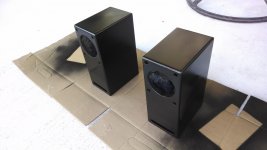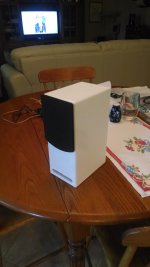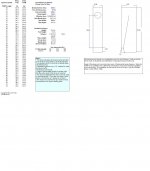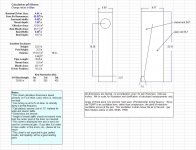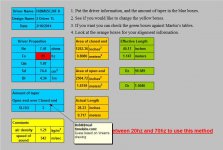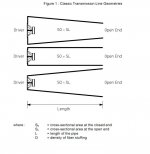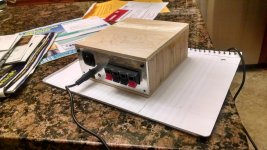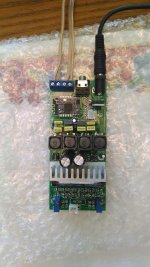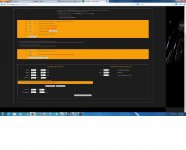Bigun:
Thanks for the reply. Here are a few more pictures. I have (4) Hiwave 3.5 inch drivers and was planning to put them 2 per speaker in a needle style enclosure based on the 3rd image. The excel sheet only looks at 1 driver so I had to calculate the area of two drivers and covert it to an equivalent area for a single driver. What do you think of this concept?
Regards,
Bob
Thanks for the reply. Here are a few more pictures. I have (4) Hiwave 3.5 inch drivers and was planning to put them 2 per speaker in a needle style enclosure based on the 3rd image. The excel sheet only looks at 1 driver so I had to calculate the area of two drivers and covert it to an equivalent area for a single driver. What do you think of this concept?
Regards,
Bob
Attachments
Member
Joined 2009
Paid Member
I love the finishing you've done of the Martello's. I may have to contract my next build to you 😀
I can't comment too much on the two-driver idea as I have little experience - I use only single drivers. But I think your approach of doubling the size for equivalent area sounds good and you will have to treat the 'combined' driver as having double the VAS too.
I can't comment too much on the two-driver idea as I have little experience - I use only single drivers. But I think your approach of doubling the size for equivalent area sounds good and you will have to treat the 'combined' driver as having double the VAS too.
The white is the primer. I copied malibujeff on the grills. Once I decided to paint them, the whole idea of the mitres seemed a waste. As far as the Vas is concerned, I not sure how the needle design takes that into account, it more or less seems to base things on the lowest frequency you want the enclosure tuned to and sets the dimensions to create a pipe of 1/4 the length of that frequency. It might take it into account somewhere in the calculations based on the area of the driver cone??
If you double up drivers, double the volume of the enclosure (keep length the same) and double the csa of the vents (use two) keep the vent length the same. The frequency response should be the same in the bass but +6dB boost (for parallel wired load at 2.83volts). Mount one front facing and one rear facing for a bipole and you get rid of baffle step losses.
Last edited:
xrk971
Thanks for your input. I am basing the enclosure sizing on the calculations from the excel sheet here:
Single Driver Website
It asks for the speaker diameter then calculates an area for the speaker and uses this area to determine the box volume as far as I can determine. Then it uses the tuning frequency to set the length of the pipe. The combination of these gives you the overall dimensions of the enclosure. If I were to use these as front speakers in a surround environment and the main speakers for audio listening, would the bipole arrangement be better than having both drivers front facing? What is a baffle stop loss? Sorry for the newb questions. Thanks for your help.
Regards,
Bob
Thanks for your input. I am basing the enclosure sizing on the calculations from the excel sheet here:
Single Driver Website
It asks for the speaker diameter then calculates an area for the speaker and uses this area to determine the box volume as far as I can determine. Then it uses the tuning frequency to set the length of the pipe. The combination of these gives you the overall dimensions of the enclosure. If I were to use these as front speakers in a surround environment and the main speakers for audio listening, would the bipole arrangement be better than having both drivers front facing? What is a baffle stop loss? Sorry for the newb questions. Thanks for your help.
Regards,
Bob
It asks for the speaker diameter then calculates an area for the speaker and uses this area to determine the box volume as far as I can determine. Then it uses the tuning frequency to set the length of the pipe. The combination of these gives you the overall dimensions of the enclosure.
Bob,
That is the classic TL design methodology... next to useless, and completely obselete since Martin King and Gearoge Augspurger developed proper TL models.
Go to Quarter Wavelength Loudspeaker Design and download his tables to get a much better approximation.
dave
Planet10:
Thanks for the advice. So I tried the tables at 1/4wave. See output and also the weems calcs. I am not sure how to interpret the 1/4wave data as far as calculating enclosure volume/dimensions and comparing to the weems data. I assumed the weems sl/so is ~2:1 based on the picture to use in the 1/4wave table- don't know if this is an accurate assumption.
Regards,
Bob
Thanks for the advice. So I tried the tables at 1/4wave. See output and also the weems calcs. I am not sure how to interpret the 1/4wave data as far as calculating enclosure volume/dimensions and comparing to the weems data. I assumed the weems sl/so is ~2:1 based on the picture to use in the 1/4wave table- don't know if this is an accurate assumption.
Regards,
Bob
Attachments
xrk971
Thanks for your input. I am basing the enclosure sizing on the calculations from the excel sheet here:
Single Driver Website
It asks for the speaker diameter then calculates an area for the speaker and uses this area to determine the box volume as far as I can determine. Then it uses the tuning frequency to set the length of the pipe. The combination of these gives you the overall dimensions of the enclosure. If I were to use these as front speakers in a surround environment and the main speakers for audio listening, would the bipole arrangement be better than having both drivers front facing? What is a baffle stop loss? Sorry for the newb questions. Thanks for your help.
Regards,
Bob
Baffle step loss is the reduction in bass due to the finite width of the baffle. The wider the baffle, the less the baffle step loss. A speaker mounted on a wall or infinite baffle has no baffle step loss. This shows up as a mid range that is too bright compared to bass. You could reduce the mids and treble via a resistor and coil in parallel and put in series with the driver (also known and baffle step compensation or BSC), or EQ it out, or have an alignment with enhanced bass that compensates for the loss.
Having a driver facing forward and backward and driven in phase (push-push) helps to reduce this baffle step loss because a virtual symmetry of an infinite wall is established from the two drivers. Having both facing forward can work but you will notice some variation in sound vs frequency as you move up and down - not a big problem to some people or of you plan on listening in a fixed seated position.
Are you trying to design a TL speaker? What about a mass loaded TL (MLTL)? They can be designed using the Accidental MLTL (AMLTL) technique if you don't quite have access to being able to simulate your own TL's yet. Search this forum for AMLTL technique to find out more. I have has quite a bit of success using it with moderate to high Qts drivers. Does not work with low Qts (<0.35) drivers.
For HT or music you might want to try a sealed fullrange with help of a subwoofer below 200 Hz. This can sound very good and give you all the benefits of a fullrange such as spatial, phase, and time coherency inherent in a point source speaker.
And they look great. Nice build. Hope you enjoy them as much as I do.The white is the primer. I copied malibujeff on the grills.
Baffle step loss is the reduction in bass due to the finite width of the baffle. The wider the baffle, the less the baffle step loss. A speaker mounted on a wall or infinite baffle has no baffle step loss. This shows up as a mid range that is too bright compared to bass. You could reduce the mids and treble via a resistor and coil in parallel and put in series with the driver (also known and baffle step compensation or BSC), or EQ it out, or have an alignment with enhanced bass that compensates for the loss.
Great explanation of BSC. If you want to see exactly how this effects this speaker, check out these very complete measurements. Danny at GR Research was kind enough to measure my Martello's. He posted the results HERE.
The wider the baffle, the less the baffle step loss.
The wider the baffle, the lower the frequency where baffle step loss starts
http://www.t-linespeakers.org/tech/bafflestep/intro-bds.html
dave.
Great explanation of BSC. If you want to see exactly how this effects this speaker, check out these very complete measurements. Danny at GR Research was kind enough to measure my Martello's. He posted the results HERE.
In his report he mentions "a small inductor and resistor" for baffle step correction. The plots after this look a lot better. Any idea what the values were that he used?
xrk971
I thought I would try to build a TL type speaker as my second diy attempt. I have several drivers (2) TB881s (3"), (4) HIBM65C20F-8s (3.5"), (2) FRS7 (2.5") and thought I would try to use the 4 larger drivers in a TL to replace my 35 yr old infinity Bookshelf speakers used in my Stereo/HT setup. I had been looking at the polk audio towers such as such as TSx330 or similar when i ran across the diy concept. Since I already have the drivers, I thought I would give it a go. My HT setup has Polk audio center & satellites, Infinity L/R and 2 10" subs. I have started to explore the AMLTL techniques you recommend and have d/l the winisd and a few other programs so will be looking at this over the weekend. the photos are the Bluetooth amp and enclosure which will drive my martellos.
Cheers,
Bob
I thought I would try to build a TL type speaker as my second diy attempt. I have several drivers (2) TB881s (3"), (4) HIBM65C20F-8s (3.5"), (2) FRS7 (2.5") and thought I would try to use the 4 larger drivers in a TL to replace my 35 yr old infinity Bookshelf speakers used in my Stereo/HT setup. I had been looking at the polk audio towers such as such as TSx330 or similar when i ran across the diy concept. Since I already have the drivers, I thought I would give it a go. My HT setup has Polk audio center & satellites, Infinity L/R and 2 10" subs. I have started to explore the AMLTL techniques you recommend and have d/l the winisd and a few other programs so will be looking at this over the weekend. the photos are the Bluetooth amp and enclosure which will drive my martellos.
Cheers,
Bob
Attachments
I do not know what he used for the BSC. Post on the GR Research forum and maybe he will share the details.In his report he mentions "a small inductor and resistor" for baffle step correction. The plots after this look a lot better. Any idea what the values were that he used?
xrk971
I thought I would try to build a TL type speaker as my second diy attempt. I have several drivers (2) TB881s (3"), (4) HIBM65C20F-8s (3.5"), (2) FRS7 (2.5") and thought I would try to use the 4 larger drivers in a TL to replace my 35 yr old infinity Bookshelf speakers used in my Stereo/HT setup. I had been looking at the polk audio towers such as such as TSx330 or similar when i ran across the diy concept. Since I already have the drivers, I thought I would give it a go. My HT setup has Polk audio center & satellites, Infinity L/R and 2 10" subs. I have started to explore the AMLTL techniques you recommend and have d/l the winisd and a few other programs so will be looking at this over the weekend. the photos are the Bluetooth amp and enclosure which will drive my martellos.
Cheers,
Bob
Good luck on your AMLTL build! That amp with integrated BT looks very nice - where do you get those? Do you have a link? I have had to connect separate BT modules and class D amps and they have ground loop noise unless isolated DC to DC converter is used.
I got the amp boards from:
http://www.digitalaudioamp.com/product/bluetoothaudioamplifier.html
They sold them to me as samples. They were pricey ~$75.00 delivered from China for 2. They have 2 models one is a bit bigger and has provision for an on/off switch built into the board and a volume control and one smaller without those features. I got one of each. I have seen where people have used a 7805 voltage regulator and tapped off the 12v supply for the amp to run the separate BT module with no Ground loop issues. I don't know but maybe the 7805 acts as an isolator of sorts??
http://www.digitalaudioamp.com/product/bluetoothaudioamplifier.html
They sold them to me as samples. They were pricey ~$75.00 delivered from China for 2. They have 2 models one is a bit bigger and has provision for an on/off switch built into the board and a volume control and one smaller without those features. I got one of each. I have seen where people have used a 7805 voltage regulator and tapped off the 12v supply for the amp to run the separate BT module with no Ground loop issues. I don't know but maybe the 7805 acts as an isolator of sorts??
7805 was the first thing I tried. It may be the type is BT module. $75 is pricey - maybe stick with my separate amp and BT with isolator.
xrk:
I d/l winisd and input parameters for the driver HiBM65C20-F
Re=7.41ohm
fs=92hz
Mms=5.77 g
Sd=37.2cm2
Qms=5.93
Qes=1.31
Xmax=3.5mm
I also entered the dimensions from the HiWave website
it calculated everything else and I saved that driver. When I start a project with that driver, 1 speaker, vented, C4/SC4 (default) then finish, I get very odd results;
Box size 362 l, vent length 301 cm. If I rerun and pick EBS3 I get 6.27 l and a vent length of 206 cm. I did not change any other parameters such as vent diameter etc. I am doing something wrong?? Thanks,
Bob
I d/l winisd and input parameters for the driver HiBM65C20-F
Re=7.41ohm
fs=92hz
Mms=5.77 g
Sd=37.2cm2
Qms=5.93
Qes=1.31
Xmax=3.5mm
I also entered the dimensions from the HiWave website
it calculated everything else and I saved that driver. When I start a project with that driver, 1 speaker, vented, C4/SC4 (default) then finish, I get very odd results;
Box size 362 l, vent length 301 cm. If I rerun and pick EBS3 I get 6.27 l and a vent length of 206 cm. I did not change any other parameters such as vent diameter etc. I am doing something wrong?? Thanks,
Bob
The port dimension and lengths look good based on 15 liter box, but predicted tuning frequency is way too low for f3 of 21 Hz!? For an fs of 92 Hz, you should be aiming for about 50 to 55 Hz. Try WinISD - that works very well.
- Home
- Loudspeakers
- Full Range
- Martello enclosure for FR88EX
